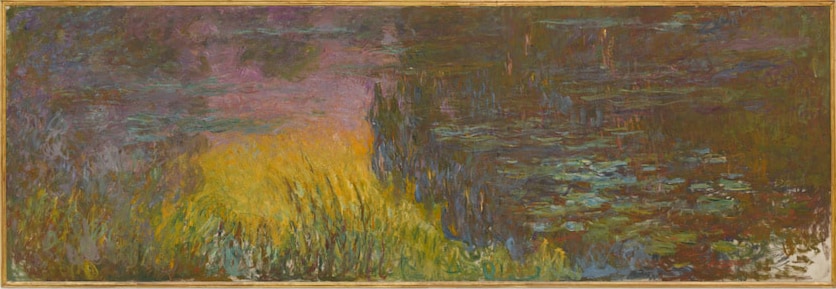NYMPHÉAS
IMMERSIVE EXPERIENCE
Dive into an idyllic world based on Monet’s masterpiece through the Orangerie Museum

Reflets d'arbres
Claude Monet Between 1914 & 1926 | H 200 ; L. 850 cm
In shades of green or dark blue, sometimes tending towards purple, Claude Monet plays with the reflections of the supple willow branches that surround his pond on the surface of the water. The flowers of the few pink and white water lilies contrast singularly with this aquatic background with its tormented touch.

Les Nuages
Claude Monet Between 1914 & 1926 | H. 200 ; L. 1275 cm
Throughout his life, Claude Monet meditated on the lessons of his first teacher, Eugène Boudin, to depict the effects of the sky and clouds. He succeeded in the feat of evoking the rosy atmospheric variations of the skies solely through their reflection in the still waters of his pond acting as a mirror in a monumental and striking composition.

Le Matin clair aux saules
Claude Monet Between 1914 & 1926 | H. 200 ; L. 1275 cm
The Clear Morning with Willows in the second room of the Orangerie collection faces an extremely similar composition stylistically, The Morning with Willows. In these two works, the expanse of water is marked by the presence of two imposing tree trunks. Here, the reflections on the water indicate a milky sky giving an impression of brightness to the scene.

Les Deux Saules
Claude Monet Between 1914 & 1926 | H. 200 ; L. 1700 cm
Located at the eastern end of the second room of the Water Lilies, The Two Willows is the largest composition in the Orangerie collection. With a length of 17m, it offers the equivalent of a panoramic view of the flat surface of the pond without any particular focal point. Only two thin tree trunks come to punctuate the whole on its edges. The elliptical shape of the wall reinforces a deep feeling of immersion of the viewer in the painting.

Soleil Couchant
Claude Monet Between 1914 & 1926 | H. 200 ; L. 600 cm
Located the farthest west and representing the sunset, it is certainly the most free and flamboyant piece of painting in the entire Orangerie collection. The daring brushstrokes and choice of colors representing the reflections of the sky and aquatic vegetation have thus been a source of admiration for many generations of painters, particularly for many proponents of abstraction in the 20th century.

Reflets Verts
Claude Monet Between 1914 & 1926 | H. 200 ; L. 850 cm
This composition is exclusively dedicated to the representation of the water of the Giverny pond. The framing not only excludes any horizon line as in all the works of the Orangerie collection, but it also deliberately ignores the banks and shoreline. The surface of the water is here made perceptible by the presence of the floating flowers and leaves of water lilies.

Matin
Claude Monet Between 1914 & 1926 | H. 200 ; L. 1275 cm
Scattered with aquatic plants, including countless water lilies that give their name to this great painting cycle of the end of the painter's life, this immense composition takes us into the heart of a continuum of time and space spread across the two rooms of the Orangerie, evoking here the gentle light of morning.

Le Matin aux saules
Claude Monet Between 1914 & 1926 | H. 200 ; L. 1275 cm
The Morning with Willows seems to respond to the composition facing it in the second room of the Orangerie collection, The Clear Morning with Willows. The framing cutting the tops of the trees and only sketching a piece of the pond's shoreline blurs the viewer's spatial references while strongly rhythmically by verticals this excessively elongated composition.